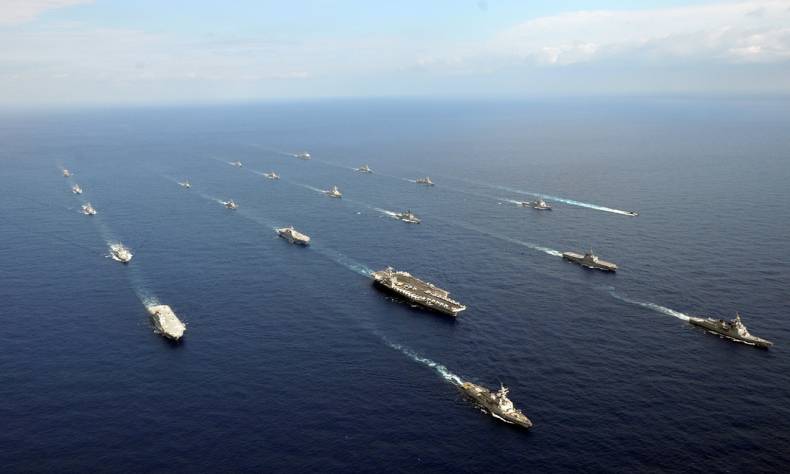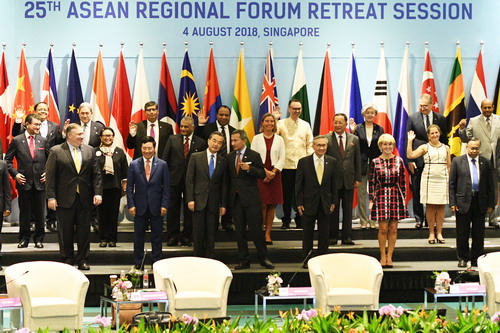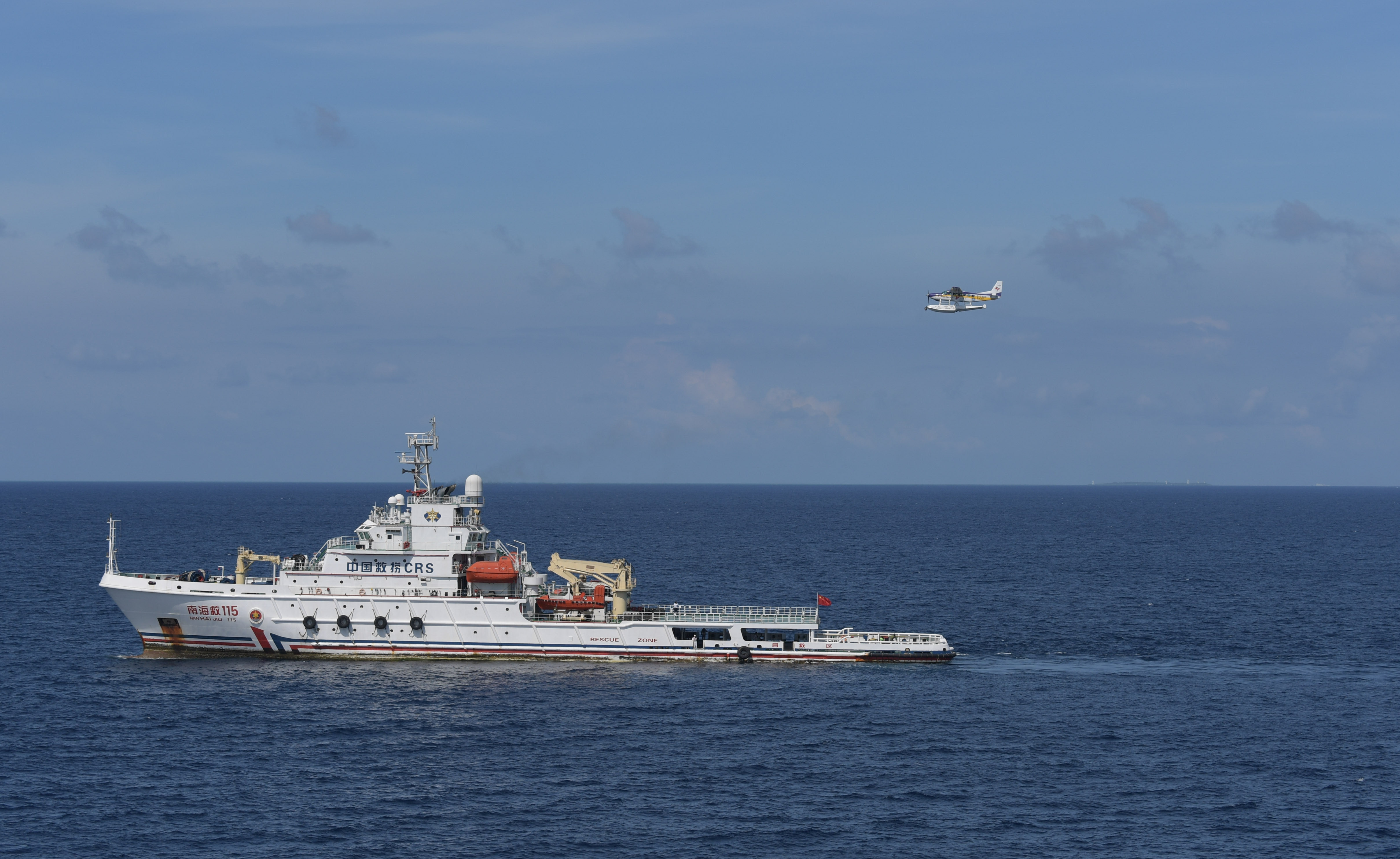
China and ASEAN Single Draft Negotiating Text of COC to Secure South China Sea Stability
Wang Yi, Chinese State Councilor and Foreign Minister, attended China-ASEAN Foreign Ministers’ Meeting in Singapore on August 2. As the rotating chairman of ASEAN and coordinator of China-ASEAN relations, Foreign Minister of Singapore announced that China and ASEAN arrived at the single draft negotiating text of Code of Conduct (COC) on the same day. This is the first move towards substantive negotiations on the COC, and also a critical move and a milestone that lay foundation and provide essential safeguard for further talks.
Δ Chinese State Councilor and Foreign Minister Wang Yi (First row, L3) attends the 25th ASEAN Regional Forum retreat held in Singapore on Aug 4, 2018.[Photo/ Xinhua]
What is the single draft negotiating text of COC?
The 14th Senior Officials’ Meeting on Implementation of Declaration on the Code of Conduct on the South China Sea (DOC), held last May, passed the framework of COC, indicating that negotiations had entered a new substantive stage. However, a series of difficulties and challenges exist in such stage, among which the foremost one is the drafting of the basic document.
As Wang Yi depicted, the progress made in these negotiations can be compared to China and ASEAN building a new house together. In the past, eleven countries had 11 plans, but now, with China and ASEAN agreeing on a single draft negotiating text of COC, we not only integrated all the plans as one, which now becomes the foundation of the house, we also built up pillars that will support the further construction. In terms of the valid scope of COC and responsibilities of each country, ASEAN members have their own propositions and interests. However, it is impossible to negotiate on the basis of 11 different texts, hence reaching a consensus becomes a must.
What does this move mean?
Since the launch of COC negotiations at the 6th Senior Officials’ Meeting on Implementation of DOC in Suzhou, China in 2013, the single draft negotiation text has gone through rounds of discussions, before a consensus could finally be reached. This move is of vital importance for the following reasons:
First, it manifests that China and ASEAN countries are capable of and confident about upholding peace and stability in the South China Sea. It strikes a powerful counterblow towards spoilers outside the region. Powers outside the region who intend to spoil the negotiations are major factors that disturb the progress of talks.
Some media and think-tanks in those countries have been picking faults and criticizing COC negotiations and constantly giving “advice” to ASEAN countries, including speculating on the “militarization” of South China Sea, increasing the scale and frequency of so-called “freedom of navigation operation (FONOP)” and drawing other countries over to participate in joint patrols, while their true intention is to take these spoiling actions as bargaining chips to make deals with territorial claimants of South China Sea, so as to deepen their influence in this region.
Against this backdrop, the official formation of a single draft negotiation text of COC hits back hard on those spoilers’ face; it tells the world that China and ASEAN countries can well manage their divergences and can sustain regional peace and stability. The ASEAN chairman’s statement published after the foreign ministers’ meeting also clearly pointed out that ASEAN is delighted with the substantive progress made on the COC.
Second, it indicates that COC negotiations are now entering a more complicated and deeper stage, and the “dual-track” approach and settling differences through talks and negotiations are right ways to maintain peace and stability in the South China Sea. The consensus over the single draft was a significant achievement in the initial stage, and it has included all of the involved parties’ interests and pursuits. It means that China and ASEAN are able to unroll negotiations that concern more detailed and specific contents over this basis now.
The mechanism and regulations of divergence control and maintaining peace and stability in the region have taken an essential stride forward. Talks between China and ASEAN countries have been rather smooth, and the single draft is exactly the epitome of their talks.
COC negotiations still a long way to go
While celebrating the major progress we have attained, we still need to be careful about the possible setbacks and challenges that we need to confront in future COC negotiations.
Due to some negative factors, including divergences among a part of ASEAN countries over certain core items in the COC, the escalating conflicts in South China Sea provoked by one or two claimants and the interference of powers outside the region, and the progressing “Indo-Pacific Strategy” proposed by Donald Trump, it will still take time to narrow divergences, establish mutual trust and reach consensus. That is why no specific timetable or roadmap for the future COC negotiations have been made, so that future negotiations can be more flexible.
Δ “NAN HAI JIU 115 (South China Sea Salvage No.115)”
Taking this meeting as the start point, the progress of the South China Sea towards peace, friendship and cooperation will become more determined. China’s most advanced marine salvage vessel “NAN HAI JIU 115 (South China Sea Salvage No.115)” has already set sail to the Nansha Islands, and is ready to provide marine salvage service to ships and vessels from different countries. China and ASEAN will hold a joint marine exercise this October to confront the security challenges together and uphold regional peace and stability. China will continue to provide other public goods including scientific researches and meteorological data for countries in the region.
With the formation of a single draft negotiation text of COC, negotiations and talks are now coming to a new stage. During this period, we hope that the international community can hold a more understanding attitude towards the talks, and allow countries in the region more flexible time and space for negotiations.
By Hu Xin, Assistant Research Fellow, National Institute for South China Sea Studies
Editor: Elena
 Facebook
Facebook
 Twitter
Twitter
 Linkedin
Linkedin
 Google +
Google +












